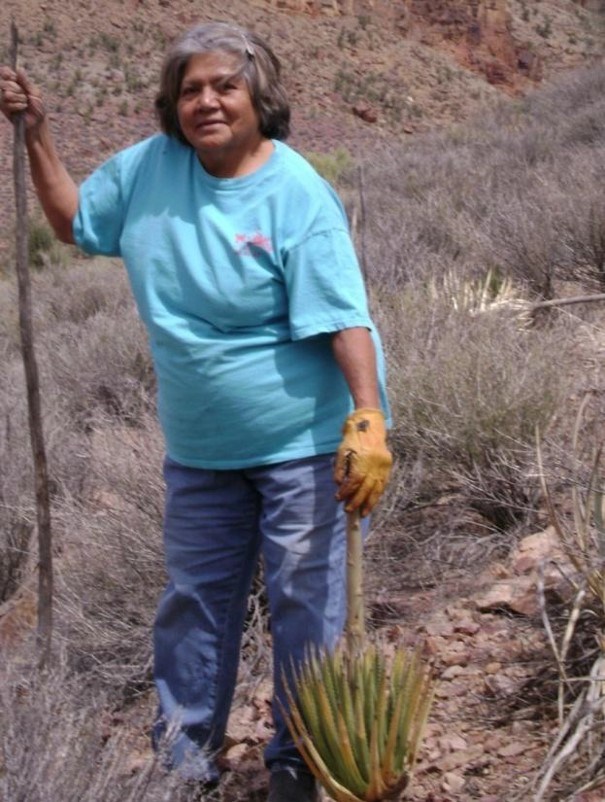Part of a series of articles titled Home and Homelands Exhibition: Resistance.
Article
Mescal Agave Knife and Malinda Powskey
Article written by Nicole Martin, PhD
Malinda Powskey ran away from an Indian boarding school at Fort Apache when she was thirteen years old. She walked for three days straight. “Stubborn, that’s the word for me,” Malinda later claimed. A member of the Big River Sandy Band of Hualapai, Malinda was born in 1940 in the scorching heat of northwestern Arizona where the Mojave and Sonoran deserts converge.1
The harsh desert environment of her upbringing made a deep mark on Malinda far beyond cultivating stubbornness. She dedicated a large portion of her life to preserving the traditional lifeways of the Hualapai, particularly ancient knowledge of the land and plants. In the final years of her life, she played a crucial role in transferring knowledge to Hualapai youth through a revitalizing ethnobotany program.2
The Life-Giving Mescal Agave

NPS Photo/Alice Wondrak Biel
Ethnobotany is the study of a region’s plants through the traditional knowledge of local cultures. The Hualapai ancestral homelands – of which a portion now lie within Lake Mead National Recreation Area – cover seven million acres and a wide range of landscapes. To the untrained eye, they appear dry and desolate. However, the Hualapai have long understood the great diversity of plant life their homeland contains in every season. One of the life-giving plants is the mescal agave, a nutrient dense food that has a sweet taste akin to molasses when roasted. Historically, both Hualapai women and men harvested the mescal agave in spring, right before the flower stocks bloom after the long winter.3
Archeologists have found mescal agave knives all over the desert southwest that date back thousands of years. The one displayed below has a wooden handle with a blade mid-shaft, likely glued on with agave resin. Prior to contact with European and American cultures, Indigenous desert cultures like the Hualapai used this tool to cut away the thorny exteriors of agave plants in order to reach the edible interior, the prized agave heart.4

NPS Photo, Lake Mead NRA, LAKE -3405-05E
Harvesting and preparing agave hearts is a multi-day process. After the agave rosettes are pried from the ground, they are taken back to the community to be de-thorned by cutting the outer leaves from the rosettes. Meanwhile, a roasting pit is dug and prepared with juniper wood and rocks placed to honor the four directions. Once the fire has been lit and the coals have burned down, the agave hearts are buried in the earthen oven overnight and enjoyed the next day.5
Revitalizing Tribal Plant Knowledge
In the late 1800s, the U.S. federal government removed the Hualapai to a reservation one seventh the size of their original territory, decreasing their access to ancestral lands and foods like the mescal agave. Soon after, the federal government forcibly removed Hualapai children to Indian boarding schools, further endangering the transfer of traditional plant knowledge. Run under a policy of assimilation, the schools forbade children to speak in their native language and engage in cultural practices.6

Carrie Cannon
Malinda came from one of the last families to live off the land. The knowledge she was taught as a child has been vital to the creation and success of the Hualapai Ethnobotany Youth Project. Beginning in 2006, this innovative program has paired Hualapai Tribal elders with Hualapai youth in order to teach them traditional plant knowledge. Through field trips and activities, including engaging in a traditional mescal agave harvest and roast, the students learn firsthand about the desert plants that once sustained their people.7
Before she passed away in 2019, Malinda explained that it is not enough to just learn about the plants and how the Hualapai traditionally cultivated them. What matters most is to think differently. “In the teaching of the ethnobotany to the children,” she explained, “we believe it is important for them to think in Hualapai, and connect to this land that is their heritage.”8 In practice, this has meant when teaching plant knowledge, it is taught in the Hualapai language. During the mescal agave roast, for example, elders speak the tribal language at each stage of the process and instruct the youth in tribal philosophies.9
Malinda understood and taught that plants, people, and land are all intimately connected. If you lose one, you lose a piece of what it means to be Hualapai.
The modern revitalization of Hualapai language and traditions has in no small part been a product of Malinda’s stubborn determination to keep traditional plant knowledge alive in all its fullness.
1 Carrie Cannon, “AERA Says Goodbye to Living Treasure,” The Plant Ambassador (Winter/Spring 2020), 5.
2 Cannon, “AERA Says Goodbye,” 5.
3 Carrie Cannon, “Ancient Wisdom, Modern Times: Decolonizing Education Paradigms in a Southwestern Tribal Community,” The Journal of Sustainability Education 18 (March 2018). See also Melissa Sevigny, “Earth Notes: Roasted Agave,” KNAU News Talk - Arizona Public Radio, November 23, 2022.
4 “Mescal Knife,” Projectile Point Identification Guide Toolstone / Lithic Database, https://www.projectilepoints.net/Points/Mescal.html
5 Cannon, “Ancient Wisdom, Modern Times.”
6 Ibid.
7 Ibid.
8 Cannon, AERA Says Goodbye,” 6.
9 Cannon, “Ancient Wisdom, Modern Times.”
Last updated: June 11, 2024
